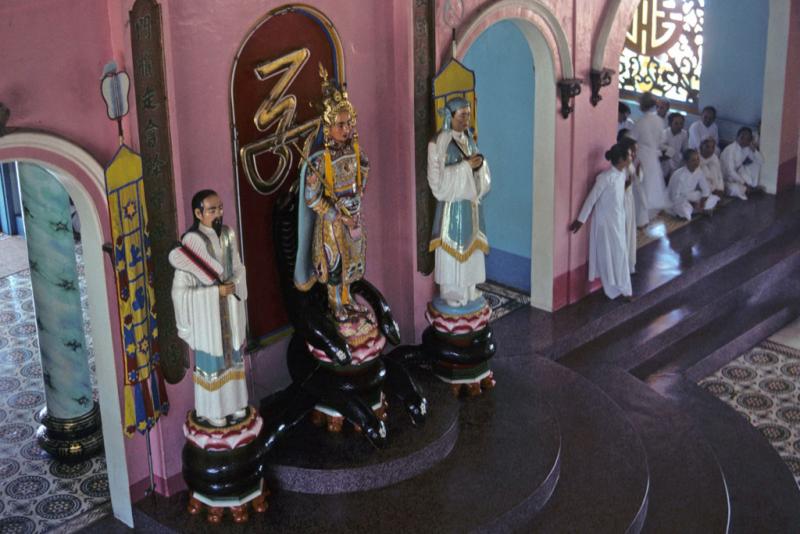Painted statues including Victor Hugo on platform in Cao Dai temple at Tay Ninh
Three painted statues on pedestals guarded by carved serpents are seen on a platform within the Cao Dai temple at Tay Ninh. The statues, including one of Victor Hugo on the left, depict saints honored in the Cao Dai religion. White robed worshippers sit and stand in a nearby alcove at right. The view is seen from a second story balcony, which allows tourists to visit the temple without disturbing worshippers' ritual activities. This elaborate temple, located about 60 miles northwest of Ho Chi Minh City, was constructed between 1933 and 1955.
Cao Dai is a relatively new religion created in the 1920s by Vietnamese spiritualists who drew upon, and added to, ideas from the four most influential religious philosophies in Vietnam: Buddhism, Daoism, Confucianism, and Christianity.
Most Vietnamese identify themselves as Mahayana Buddhists, but their religious life is replete with popular Chinese and indigenous animist elements. Almost ten percent of Vietnamese identify themselves as Roman Catholics, a legacy of French colonial missions. Cao Dai is now the third most popular religious affiliation in Vietnam with about seven million members. Tens of thousands of Cao Dai followers live in other nations, including the United States.
"Cao" literally means "high," while "Dai" means "tower," "palace," or "abode." The combined verbal image is used to represent both a heavenly place and a Supreme Being envisioned as creating all religions and beings on the earth. The visual symbol used by Cao Dai followers for this Supreme Being is an all-seeing eye. Cao Dai's founder, Ngo Van Chieu, had a vision that the union of East and West, religious and secular philosophies would lead to a more peaceful and tolerant world. The French writer Victor Hugo was among the Westerners particularly admired as saints by Cao Dai founders. His likeness appears in their temples along with images of Chinese nationalist leader Sun Yat Sen and honored Vietnamese poets. The temple also displays images of the Daoist poet Lao Tze, Confucius, Buddha, and Jesus.
Vietnam's new inclusive faith rapidly attracted a national following, so it gradually became perceived as a threat by the French government, the Catholic Church, the Communists, and the South Vietnamese regime. After the North Vietnamese Communists won the Vietnam War in 1975, the Cao Dai religion was heavily persecuted, but it continued underground and spread with those who fled the country to other parts of the world. Since the Vietnamese government agreed to accept it in 1997, it is practiced openly again, with regular ceremonies at the main temple near Ho Chi Minh City.

Creative Commons BY-NC-SA
This item has a Creative Commons license for re-use. This Creative Commons BY-NC-SA license means that you may use, remix, tweak, and build upon the work for non-commerical purposes as long as you credit the original creator and as long as you license your new creation using the same license. For more information about Creative Commons licensing and a link to the license, see full details at https://creativecommons.org/licenses/by-nc-sa/4.0/.